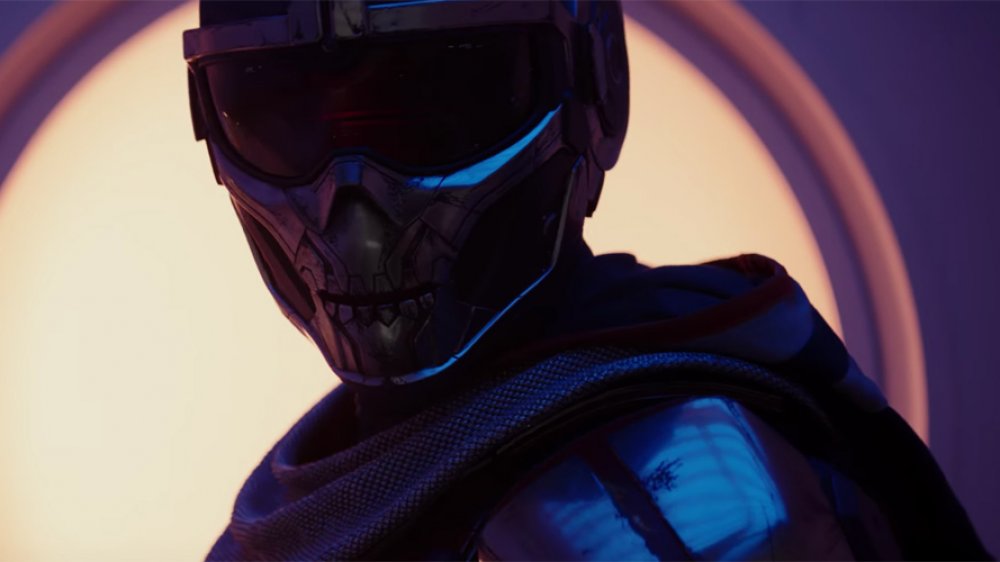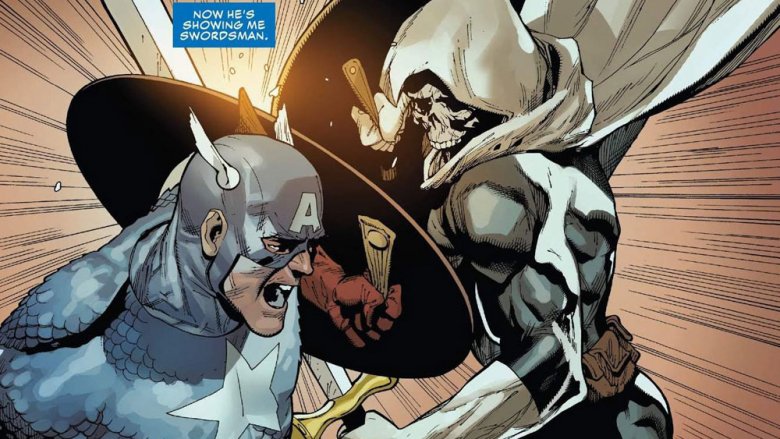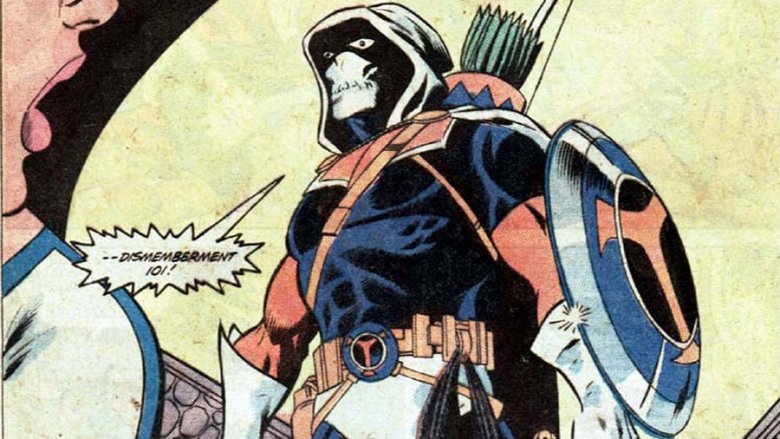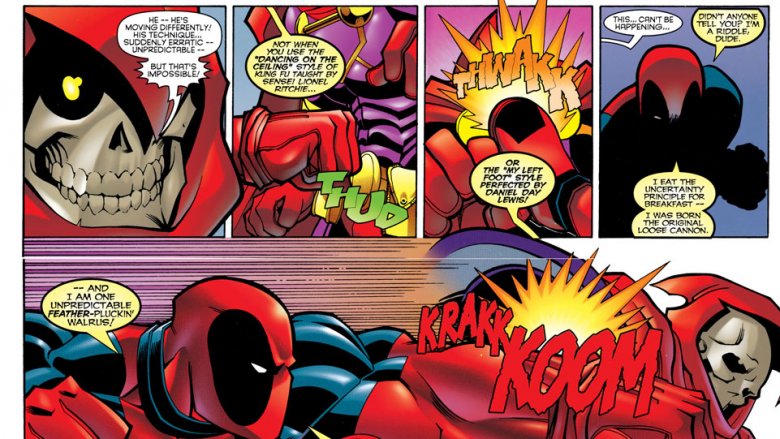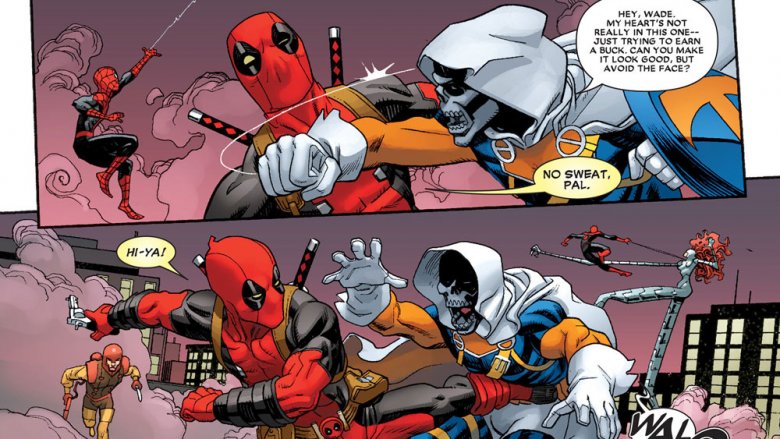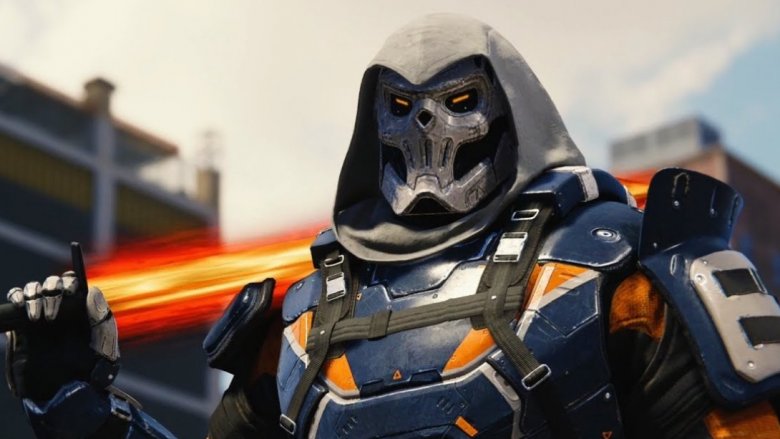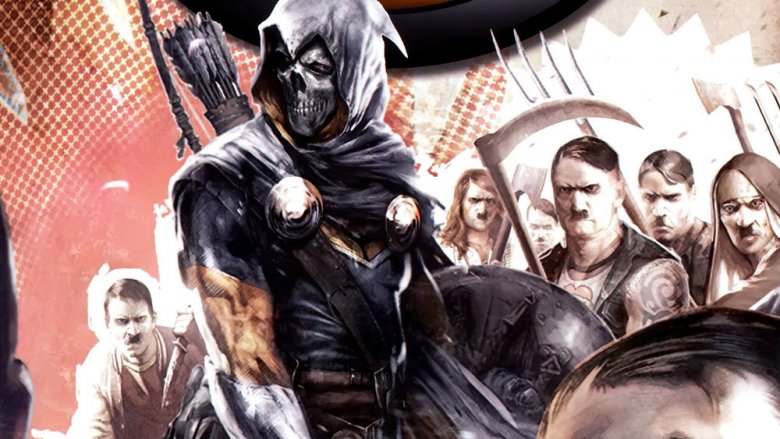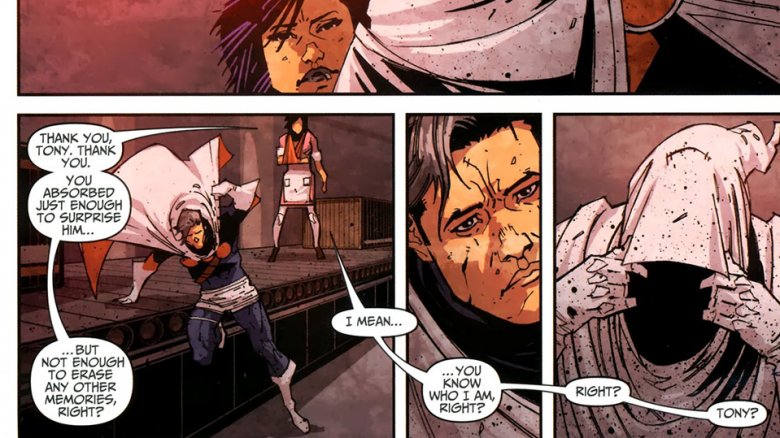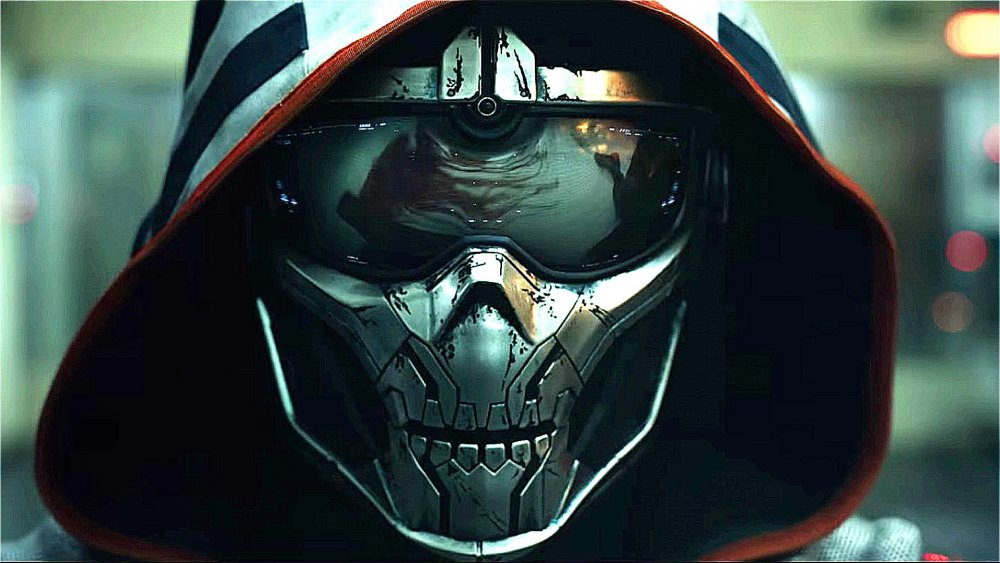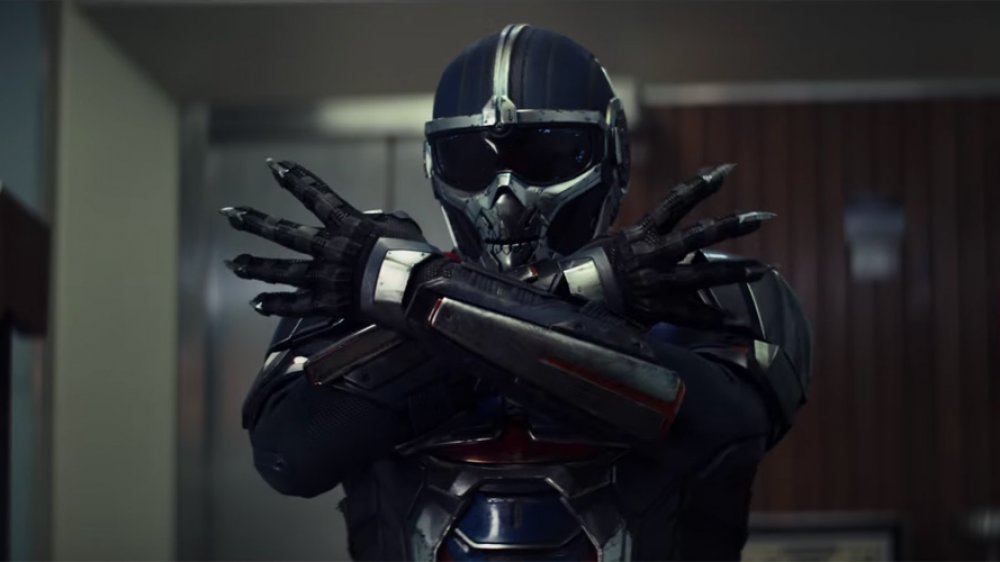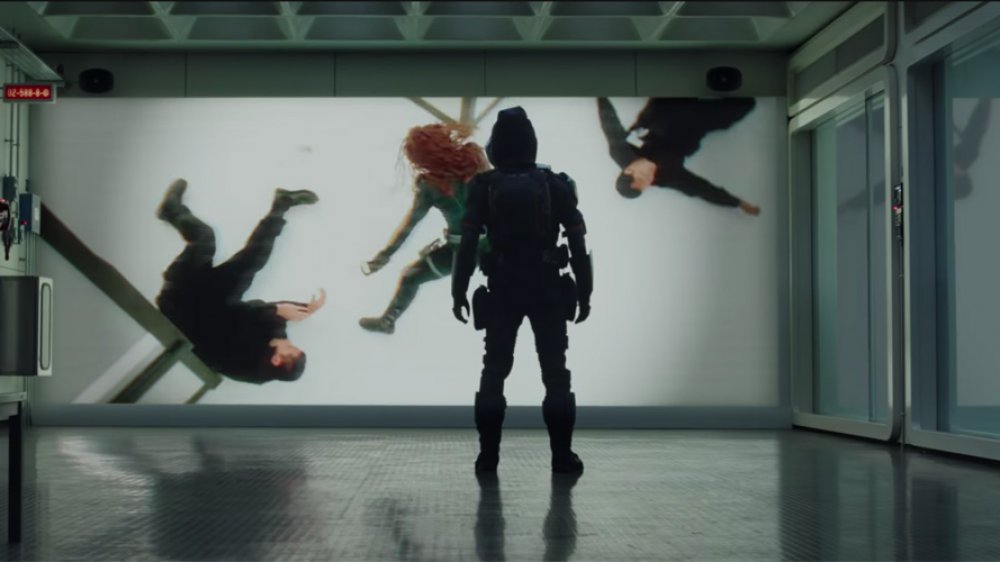The Untold Truth Of Taskmaster
The Taskmaster that we see in the Black Widow movie seems pretty faithful to his comic book roots — perhaps surprisingly so, given how other Marvel Cinematic Universe villains have been changed from their source material for the screen. The version of Helmut Zemo that we see in Captain America: Civil War, for instance, is a drastic departure from the costumed Master of Evil that we see in classic Avengers stories like Under Siege, even if it would've been truly amazing to see that exact same movie play out with Daniel Brühl wearing a purple ski mask capped off with a golden crown.
Taskmaster, on the other hand, is more in the vein of Hela, Thanos, and even Batroc the Leaper, all of whom made it to the big screen with most of their visual identities intact (the key word there being mostly; R.I.P. to Batroc's waxed mustache). The look is almost exactly what you'd expect from a live-action adaptation of Taskmaster's original George Pérez costume, with a little bit of the mid-2000s Udon Studios redesign thrown in. He's even got the shield with the big T on it, something that might've seemed unforgivably comic booky back before the MCU, but works just fine in a world where we've seen a giant purple spaceman try to destroy the universe with a handful of magic rocks. Taskmaster's mask in particular is notable, as it maintains the skull imagery while also completely obscuring his eyes with a visor that makes him look like the Soviet Union's Cold War-era attempt to recreate Vic Rattlehead, the mascot for Megadeth. It's a strong look, and in completely reducing his face to a grinning skull — something that wasn't really done for the MCU takes on other comic book characters with similar looks, like Crossbones — it separates him visually from any humanity, something that seems to be a theme in the film.
It also has a few not-coincidental practical benefits, too. Completely obscuring the Taskmaster has allowed Marvel Studios to promote the film without revealing the mystery of who's under the mask, something that's pretty surprising for a pop culture juggernaut that ranks among some of the most-promoted franchises of all time. Perhaps more importantly, it also allows the film to easily replicate the coolest thing about Taskmaster's powers: he fights like everyone, all at once. Put them in that costume, and a stunt double who's good at archery and one who can replicate Black Panther's distinct fighting style can pretty easily pass for the same guy. It's Marvel movie magic!
Anything you can do...
The Taskmaster made his first appearance in 1980's Avengers #195, arriving on the last page to set up his full appearance in the next issue and kick off a long career as one of those perfect villains who could pop up anywhere at any time. Created by David Michelinie and George Pérez, his entire identity was built around one simple idea: Anything you can do, he can do better. Or if we're being a little more accurate about it, anything you can do, he can do it just like you can.
The Taskmaster's power is usually referred to as "photographic reflexes," which is a fancy way of saying that if he sees someone doing something, he can replicate that action exactly, and he keeps that skill for the rest of his life. That would be a pretty impressive ability in the real world, where he could punch like Muhammad Ali, kick like Megan Rapinoe, dodge like Jackie Chan, and dance like Bruno Mars, but this is a dude who lives in the Marvel Universe. He can settle in with some footage of Spider-Man or Black Panther, and hop off the couch a few hours later with the ability to perfectly replicate their movements.
Of course, there's one interesting limit to all this: photographic reflexes are Taskmaster's only power. That means that while he can watch Captain America throwing his shield or Iron Fist doing kung fu, he can only replicate the movements. He doesn't have the Super Soldier Serum-enhanced strength behind the throw or the ability to channel the power of an immortal dragon into his hand. The same goes for more mundane abilities, too. He can shoot a bow and arrow just like Hawkeye, but he doesn't have Clint Barton's uncanny accuracy, and while he can spend all day watching Wolverine, nothing's going to stop a baseball bat from cracking his decidedly non-adamantium-coated skull. Still, he's come away from his battles against the Avengers with some pretty impressive abilities.
The Taskmaster Academy
While he's done his share of hands-on villainy, the Taskmaster's true calling has always been a more noble one: education! That's right, everyone. He's a teacher, spending his time giving of himself and his knowledge to shape the minds of tomorrow.
Okay, fine, the Taskmaster's version of education isn't that great, especially when you consider that his "school," the Taskmaster Academy, is less of a learning institution and more of a for-profit training center for henchmen. Really, though, that's probably the best career to get into when your most marketable skill set is doing jump kicks like Steve Rogers. For a low price, Taskmaster takes on classes of aspiring supervillains, and teaches them how to not only fight like superheroes, but more importantly, how to fight against them. There's no better way to prepare for fighting Captain America than by training with a guy who can fight exactly like Captain America, but who doesn't actually want to give you a concussion with his shield and send you off to super prison.
While this mostly functions as a pretty amazing explanation for where all the masked members of Hydra and AIM get the confidence to try to punch out Iron Man or whomever, it's worth noting that it's not just the bad guys who've taken advantage of the Taskmaster's skills. He's also been responsible for training John Walker — better known as U.S. Agent — during his brief stint as Captain America, and for training recruits for the government after the Superhero Registration Act passed during Marvel's 2005 Civil War event.
Taskmaster's tricky fighting style
There's one more interesting limitation to the Taskmaster's powers, and it actually comes from the classic idea of taking a character's greatest strength and turning it into a weakness.
In this case, it comes from the fact that the Taskmaster is something of a jack-of-all-trades. He's devoted his life to memorizing the fighting style of virtually every other Marvel character you've heard of, from Daredevil's graceful ninjitsu and Wolverine's all-out brawling to the weapon-based offense of characters like Elektra. In other words, he's spoiled for choice when it comes to taking on an opponent. All he has to do is choose which moves to throw together, and then switch up styles at a moment's notice to keep his opponents off-balance. The bad news is that when he's on the defensive, he only has a split second to choose how to react. Does he dodge like Spider-Man, take the hit with a shield like Captain America, or bust out a counter-move like Black Widow?
Under normal circumstances, that's not a problem, but when he tried to use Deadpool as a training dummy, he hit a pretty huge snag. The Taskmaster can adapt to almost any situation that he can predict, but as you may already know, Wade Wilson can be pretty unpredictable. When Deadpool started a dance-off in the middle of a fight, his erratic (yet strangely rhythmic) movements caught the Taskmaster by surprise, since none of the people whose moves he was copying had ever busted out the Macarena in the heat of battle. Deadpool scored the victory, and while it didn't exactly go as planned, Taskmaster and his students learned a valuable lesson.
The Deadpool connection
Like Deadpool, the Taskmaster made his living as a super-powered mercenary for hire when he wasn't running henchman classes, meaning that the two characters ran in pretty similar circles. While their first encounter didn't exactly end on the best of terms, they'd end up encountering each other pretty often, and that led to a friendship.
One of the Taskmaster's most prominent roles in the comics — arguably even more well-known than his own solo miniseries — came when he was a member of Deadpool's supporting cast. His frequent appearances were mostly due to the fact that Deadpool hired Taskmaster's ex-girlfriend, Sandi Brandenberg, to be his secretary. But when Deadpool blew up, lost his memory, changed his codename to Agent X, and was then revealed to have not been Deadpool all along (it's a long story that's actually even more complicated than it sounds), Taskmaster helped to re-train him as an assassin and later fought alongside him.
In more recent years, the two mercenaries have had a more back-and-forth frenemy relationship. They've occasionally come to blows while on opposite sides of a conflict, but Deadpool was also willing to help Taskmaster out by going easy on him in a fight so that Taskmaster could still get paid. He even invited Taskmaster to his bachelor party before he was married to Shiklah, a succubus who was also Queen of the Undead. That, as you might suspect, is also a long story.
Taskmaster does whatever a spider can
The Taskmaster's status as a sort of utility player of the supervillain world — a bad guy who could reasonably show up and fight pretty much anyone without having to spend too much time explaining why — has led to more than a few minor roles in projects outside of comics. The most prominent one, at least until Black Widow hits theaters in 2020, has been his presence in 2018's Spider-Man for PlayStation 4.
In the game, the Taskmaster occasionally shows up to challenge Spider-Man, but he does so in a way that suits how his character works in the comics. Rather than confronting him directly at first, Taskmaster first sends his students into battle against the web-slinger, which is the kind of final exam that could give anyone test anxiety. Presumably, he does this so that he can get a good look at Spidey in battle, which leads to the fight where he actually does show up, doing a pretty passable impression of Spider-Man's own moves. The one major difference is that Spider-Man tends to rely on web-shooters, rather than the actual laser-sword that the Taskmaster brings to the fight.
This all leads to the reveal at the end of the game, where Taskmaster tells Spider-Man that he was tasked, masterfully, with testing Spidey's abilities on behalf of an interested organization that's looking to recruit the wall-crawler. Unfortunately for Spider-Man, he gets a little self-righteous and turns down the offer before learning they pay a six-figure salary that could definitely keep him in web fluid for quite some time. He doesn't even bother into finding out whether it's good guys (like S.H.I.E.L.D.) or bad guys (like A.I.M.) who are looking at giving him a job. Of course, given the ol' Parker Luck, it'd probably be the League of People Whose Uncles Are Very Much Alive.
The town that was Hitler
Okay, so here's where it gets weird. While he's mostly shown up as a villain or a supporting character, the Taskmaster has dabbled in being a protagonist in his own right thanks to two self-titled miniseries. The first is a relatively straightforward action adventure — although it does include the interesting note that if he watches things at double-speed, Taskmaster actually can move at twice the speed of a normal human for a few seconds at a time — but the second story by Fred Van Lente and Jefte Palo is full-on bananas.
The main premise is that the Taskmaster, ironically enough, has a memory problem. His brain is so loaded up with Shang Chi's punches and Daredevil's backflips that his muscle memory has overwritten other, less important things, like his past. In order to keep himself centered, he has to keep tracking down his own memories, following his history so that he can piece it together and figure out who he is. It's sort of like Memento meets Johnny Mnemonic, only a million times weirder. The path to Taskmaster's memories leads him through things like an encounter with Don of the Dead, a Latin-American drug dealer who turns out to be a white American S.H.I.E.L.D. agent who'd taken the "Don of the Dead" identity after Taskmaster trained him, something Taskmaster doesn't remember.
That, however, pales in comparison to where that series ends up: Wewelsburg II, a small town in the Bolivian Andes where Nazi scientists escaped to after World War II in order to continue their experiments cloning Hitler. The most successful result was the long-time Marvel villain the Hate-Monger (who first showed up back in 1963), but the scientists wound up with a gigantic stockpile of cloned Hitler-brains, which leaked the Fürher's "bio-chemical essence" into the local water supply. The result? Every man, woman, and child in the town essentially has Hitler's brain, leading to a constant warfare among themselves for control of the town. So, you know, the next time someone tries to tell you how serious the Punisher is or whatever, remind them that he lives in the same world at Hitler Town.
The Taskmaster is Tony Masters
Beyond Wewelsburg II and the Don of the Dead, the big reveal of the Taskmaster series is that it finally gives us the Taskmaster's origin and his real name. That was what he'd forgotten, the piece of knowledge that sent him on that bizarre quest, and the answers change almost everything.
For years, the Taskmaster had been getting his orders from a secret organization called "the Org." But as it turns out, the Org doesn't exist. Instead, it's the wife that Taskmaster doesn't remember having, Mercedes Merced, who was also his partner back when he was a S.H.I.E.L.D. agent named — wait for it — Tony Masters. As Nick Fury tells Steve Rogers, the Taskmaster has been a good guy all along. He just doesn't remember it
As Masters, he was sent to infiltrate the supervillain community for S.H.I.E.L.D., using his powers and creating the Taskmaster identity as his cover. Unfortunately, thanks to a flawed prototype of the Super Soldier Serum that expanded his powers, all of those skills he'd absorbed overwrote the personal parts of his memory. Mercedes has been minimizing the damage for years by creating the Org, acting as Taskmaster's handler, and pointing him in the right directions for S.H.I.E.L.D. Of course, once he discovers all this, he immediately has to absorb yet another sequence of physical actions, forgetting the revelations about Tony Masters and putting a heartbroken Mercedes right back into the role of working with a husband who doesn't remember she exists.
Taskmaster: The Movie
While it's doubtful that the Don of the Dead or the Taskmaster Academy's acclaimed henchman resource program will make it into the MCU, it's not difficult to imagine how Taskmaster's presence could be felt in the upcoming Black Widow movie.
Most of Natasha Romanoff's history has to do with her training in the Red Room, a secret Soviet program designed to create a series of highly trained agents who are given the codename of Black Widow. Of course, that actually already exists in the films. In addition to being briefly shown in Avengers: Age of Ultron, the Red Room also produced Peggy Carter's nemesis, Dottie Underwood, on the Agent Carter TV show. With the Taskmaster's history of training supervillains, and his ability to serve as the perfect teacher in virtually any style of combat, it's easy to picture him as one of Natasha's trainers ... and maybe even the person who's sent to clean things up once she defects to S.H.I.E.L.D.
Sure, that's a pretty straightforward espionage plot, but it's also one that could fit neatly into the world of the MCU. Then again, given that we've seen Infinity Stones, Celestials, time travel, the Quantum Universe, and a talking raccoon in those movies, there's always a chance — no matter how slim it might be — that Taskmaster and Widow will end up fighting a climactic battle in Wewelsburg II. Seeing Marvel characters beating up a couple hundred Hitlers might just make Black Widow the feel-good movie of the year.
Shot for shot
Even more than the visual, the Black Widow version of the Taskmaster captures the character's signature abilities with an accuracy that's really exciting, both for longtime comics readers and the MCU fans who have never picked up a comic in their lives. There are, after all, two dozen movies in the Marvel Cinematic Universe at this point, including the massively successful two-parter of Infinity War and Endgame, which had a ton of screen time devoted exclusively to all of those characters engaging in one gigantic fistfight. Moviegoers have seen these characters in action for over a decade, and whether they realize it or not, they've seen how those movies distinguish their characters in ways that go beyond their costumes.
Captain America, Black Panther, and the Winter Soldier, for instance, all essentially have the same set of superpowers — enhanced strength, speed, and durability, if you want to get into trading card terminology — but they each have a fighting style that doesn't look like the others. You're not going to see Black Panther deliver that one sternum-shattering Muay Thai kick like Cap does, and you're not going to see Bucky Barnes pull off the same acrobatic attacks that T'Challa busts out, either. You will, however, see the Taskmaster do it all.
In the Black Widow trailer alone, we see him perfectly mimicking Captain America throwing his shield, Hawkeye's draw with his bow, and Black Panther's claws, among other moves. What's more, Black Widow seems to be making an effort to not just copy the style, but to mimic specific moments from earlier films. The shot with his claws in particular bears a striking resemblance to a shot from the chase sequence in Berlin from Civil War. It makes a lot of sense in the context of the films; the Battle of Manhattan in The Avengers almost certainly has to have been the most covered news story in that world's history, which would give him plenty of footage to learn from. For us in the audience, though, it's almost like he's watched the movies, which is kind of a neat little reward for paying attention in the audience. In fact, watch that trailer — there's a part where he's literally just watching Iron Man 2.
Mastering Tasks
Much like the way that the comic book Taskmaster ran his school for aspiring supervillains, the cinematic version has also embraced his calling as a teacher. This time, he's the guy running the Red Room, the top-secret Russian training facility that produces the super-spies of the Black Widow program. As a result, he's someone that our most familiar Black Widow, Natasha Romanoff, knows from her past. He's also apparently responsible for training Yelena Belova, the second Black Widow in the comics who initially set out to eliminate and replace Natasha long after the original's defection to S.H.I.E.L.D,, who is played in the film by Florence Pugh.
The fact that it's the Taskmaster, however, adds another layer to the story of Black Widow returning to the Red Room with the intention of taking it down. Not only does the Taskmaster's ability to replicate any movement that he sees make him the perfect combat instructor, it also hints at something that might just be the true purpose of the modern MCU Red Room. Outside of a brief, hallucinatory flashback in Avengers: Age of Ultron, we never really see much of what Natasha's training was like in the MCU, and what we do see seems like some pretty standard stuff — or at least as standard as it can be when you're training someone to be so good at being an assassin that it got her onto a team with the literal God of Thunder. Guns, martial arts, ballet. You know. Russian spy stuff.
The fact that Taskmaster can fight like the Avengers, though, might just mean that this resurrected Red Room isn't just training its soldiers to take on enemy spies. In the comics, the thing that makes training with the Taskmaster such an alluring prospect is that if you're sparring with a guy who fights exactly like Captain America, (or Black Panther, or Iron Fist), then you might just figure out how to beat Captain America. If that sounds like a long shot, consider that Cap and the Winter Soldier, the product of a similar, Red Room-adjacent program, laid a beatdown on Iron Man that was about as devastating as the one Thanos did. If the Red Room is turning out soldiers designed specifically to take down superheroes, and each one of them is as good at what they do as our own Black Widow is, then there's a very good reason why Natasha would want to take them down that goes well beyond revenge and atoning for her own dark past.
